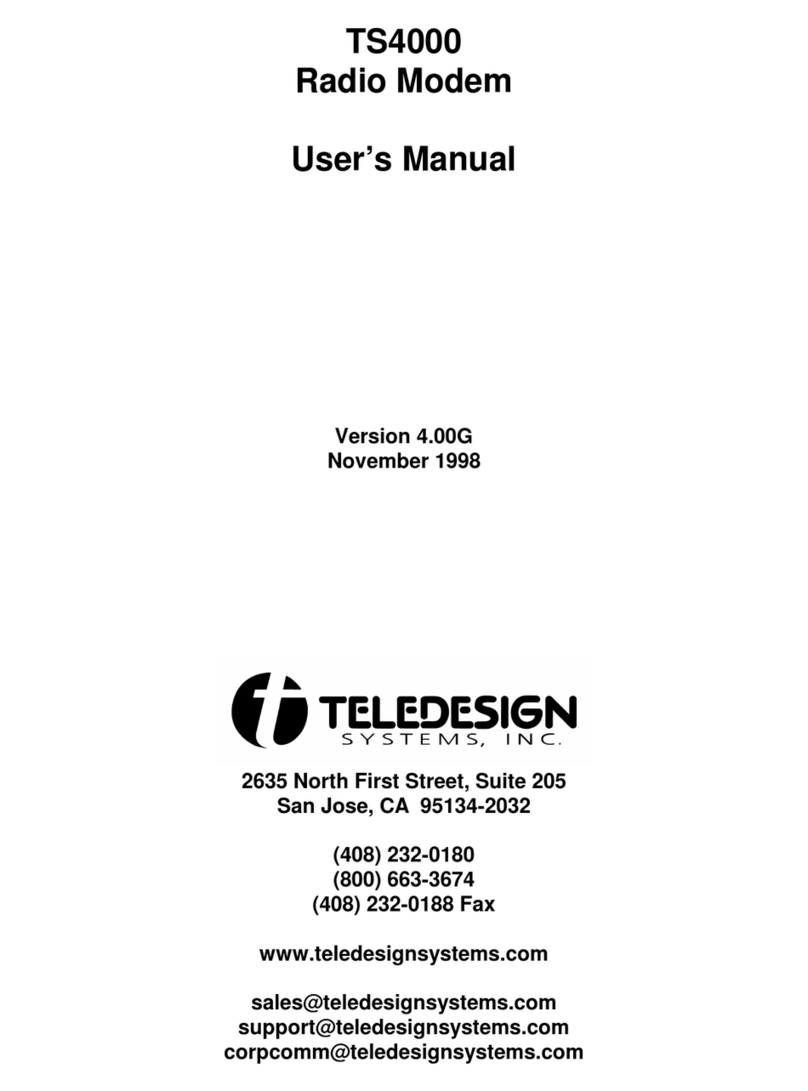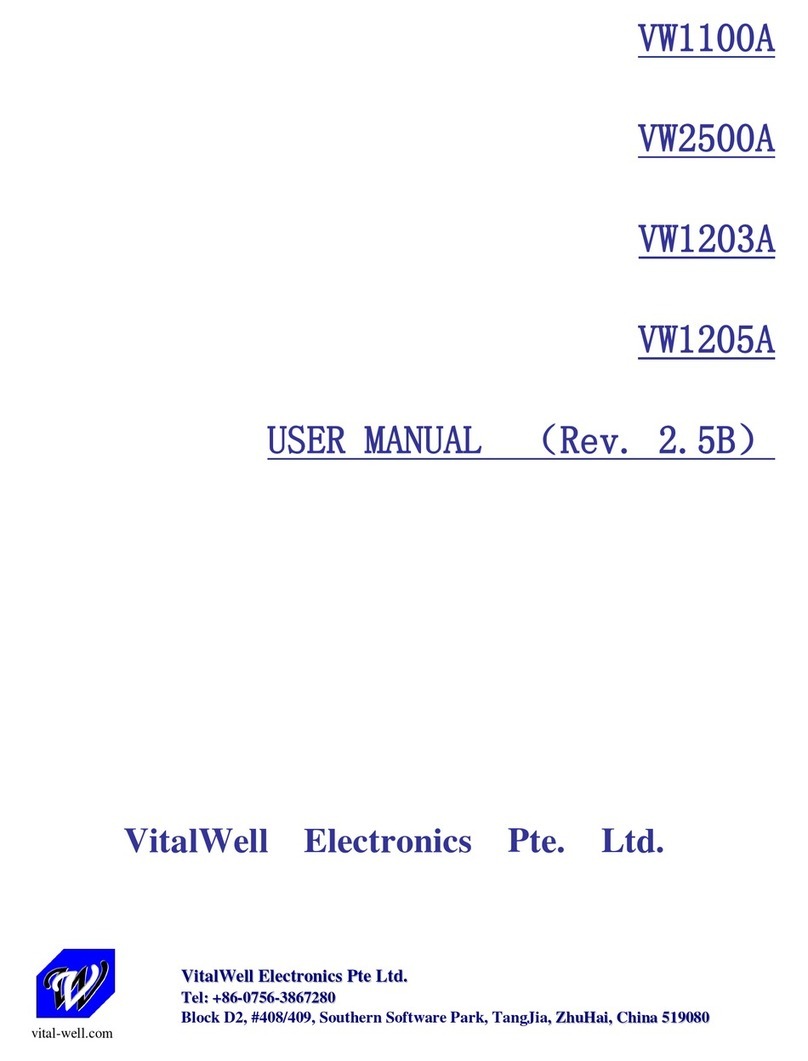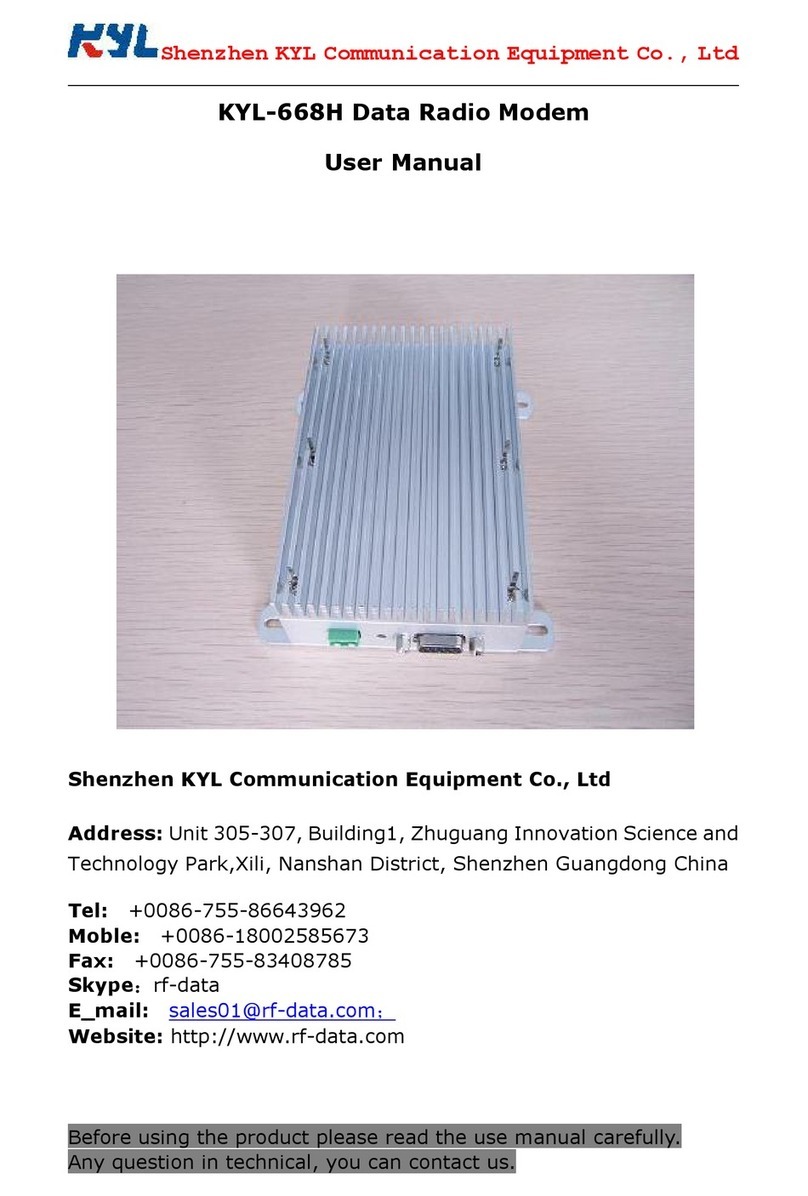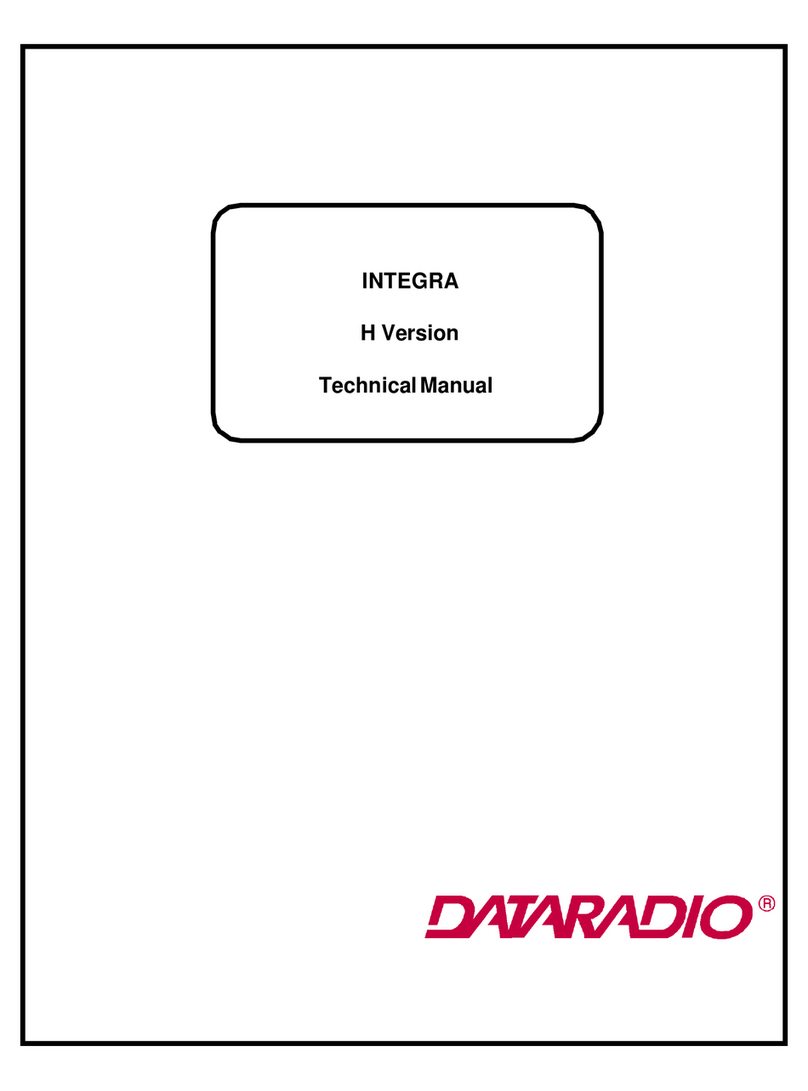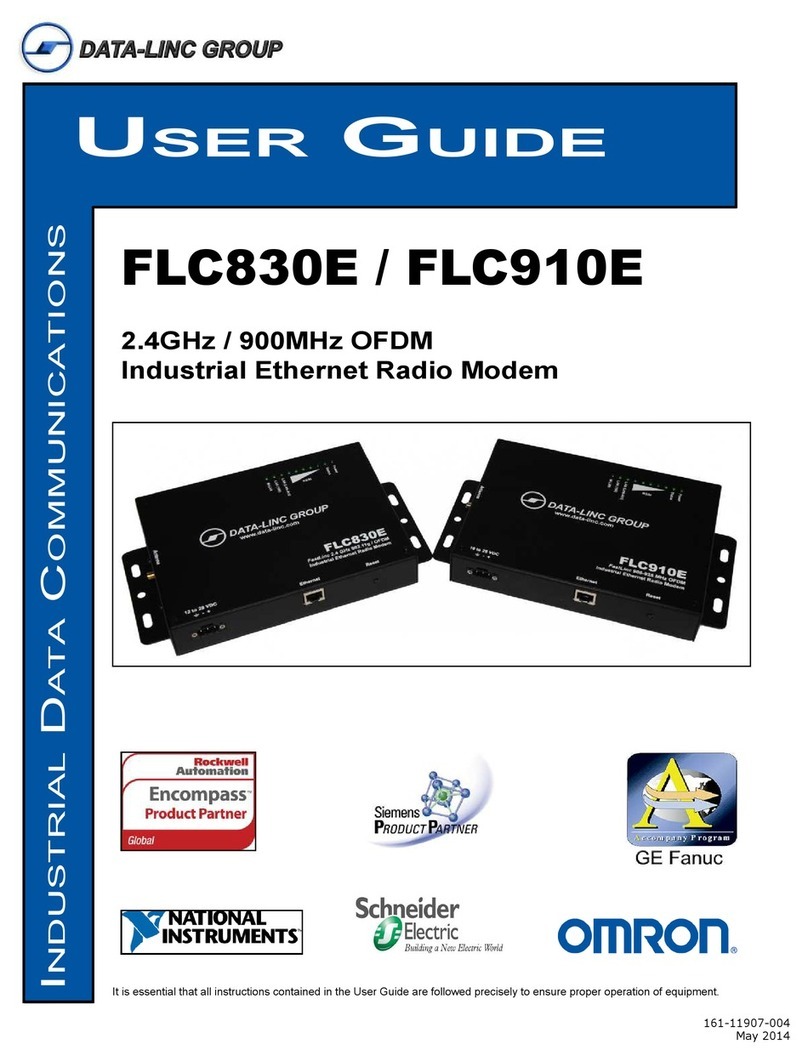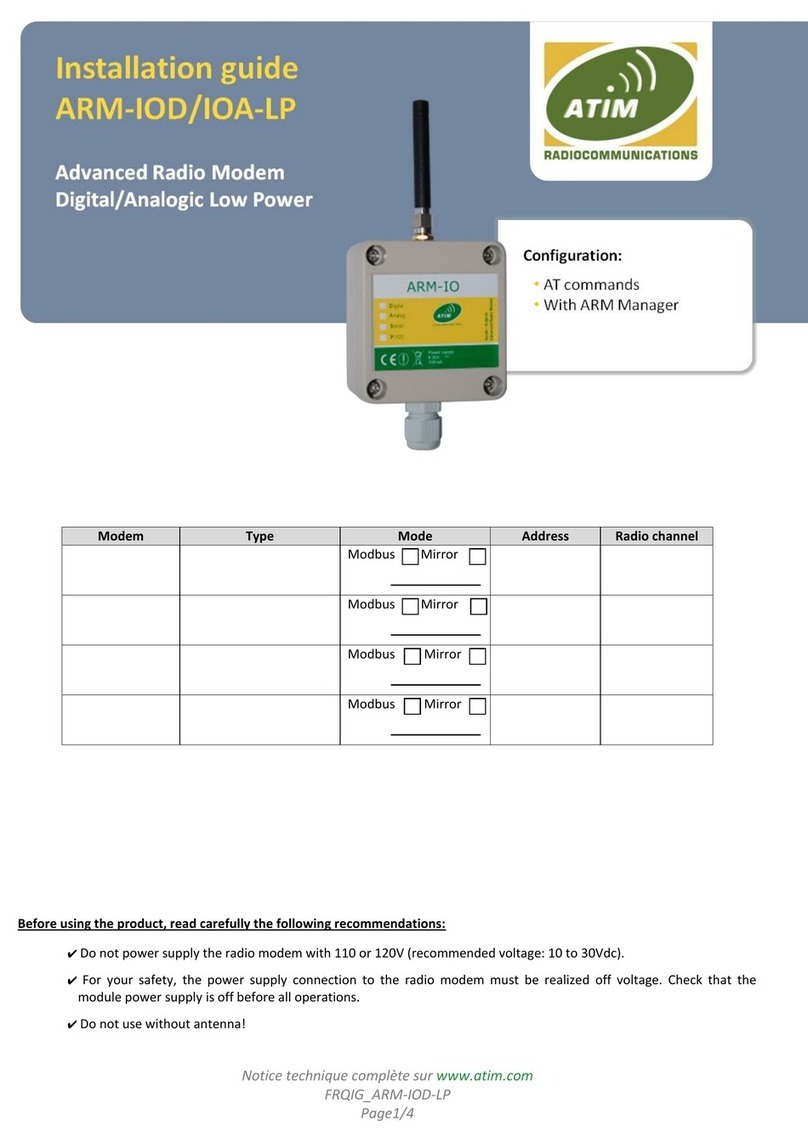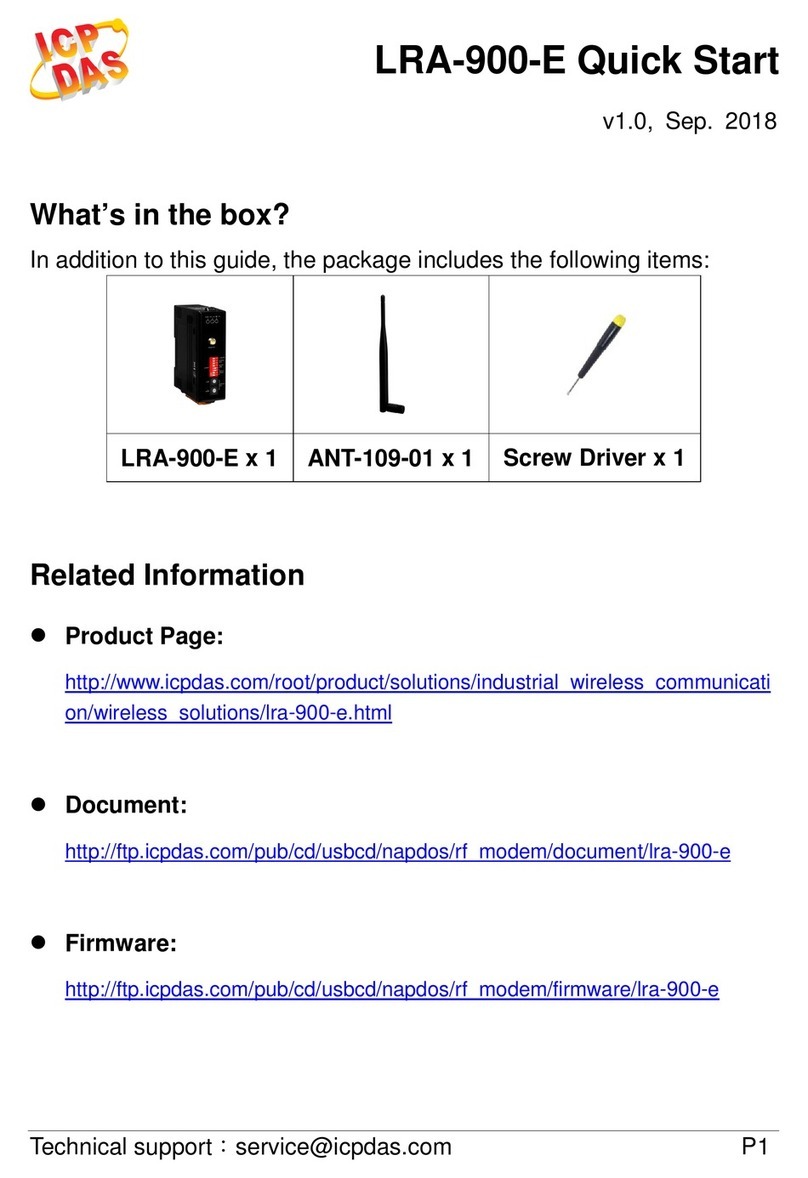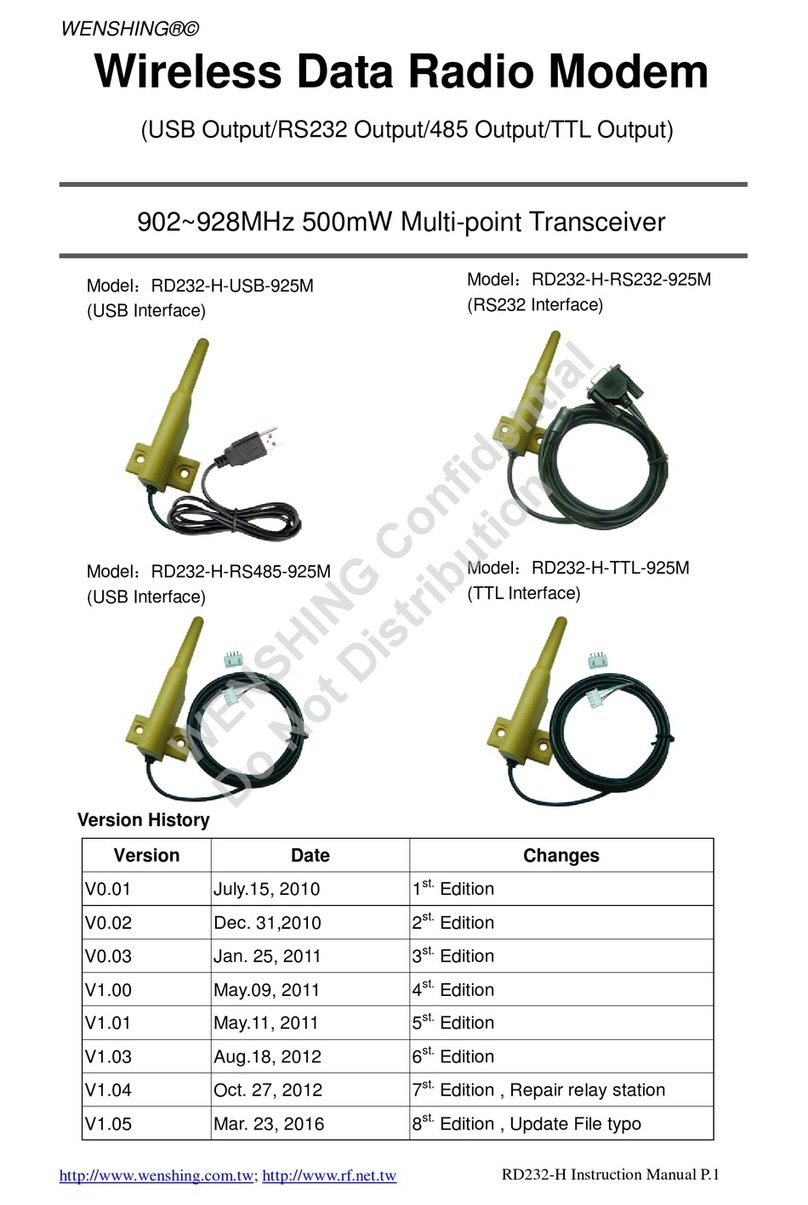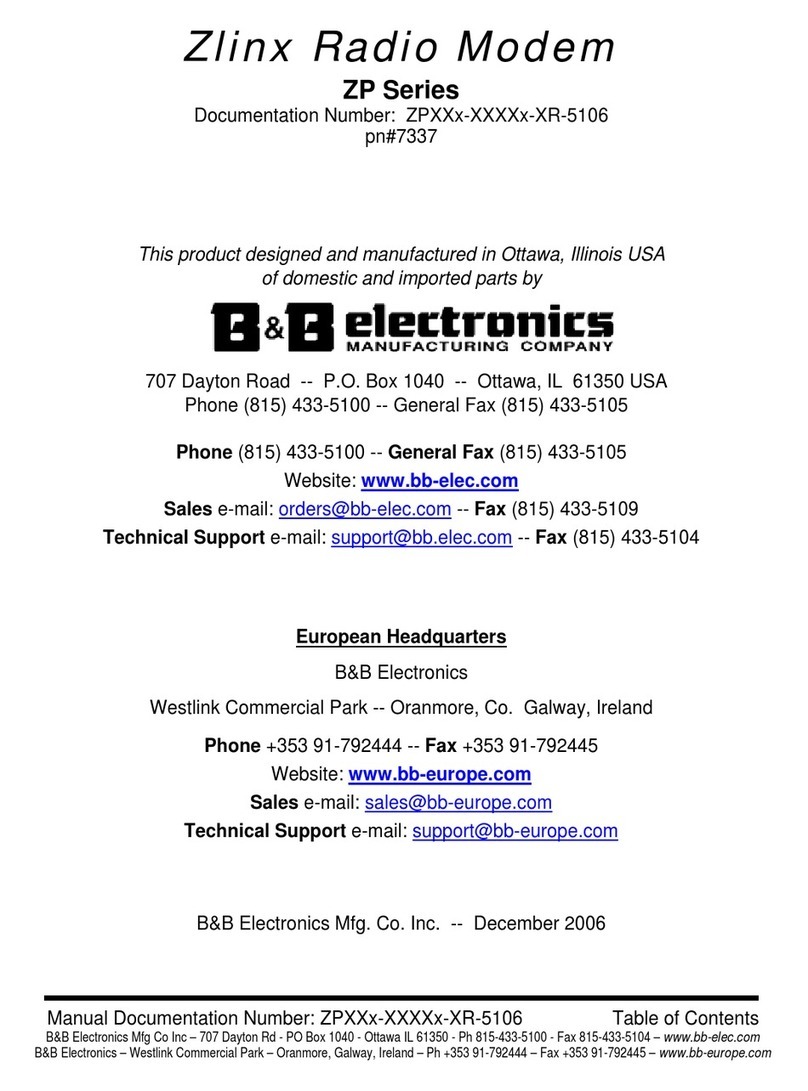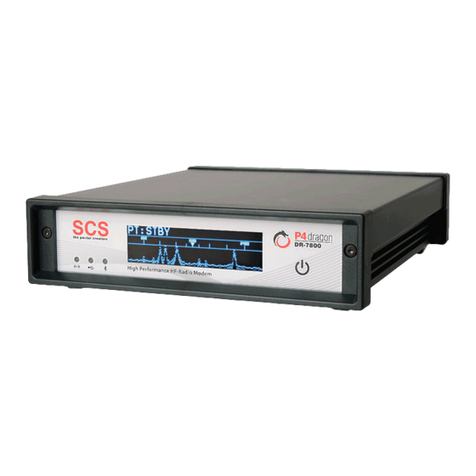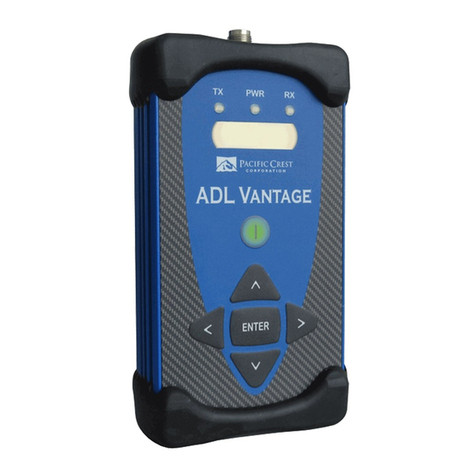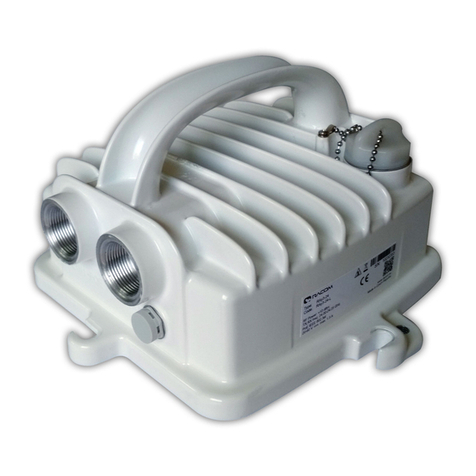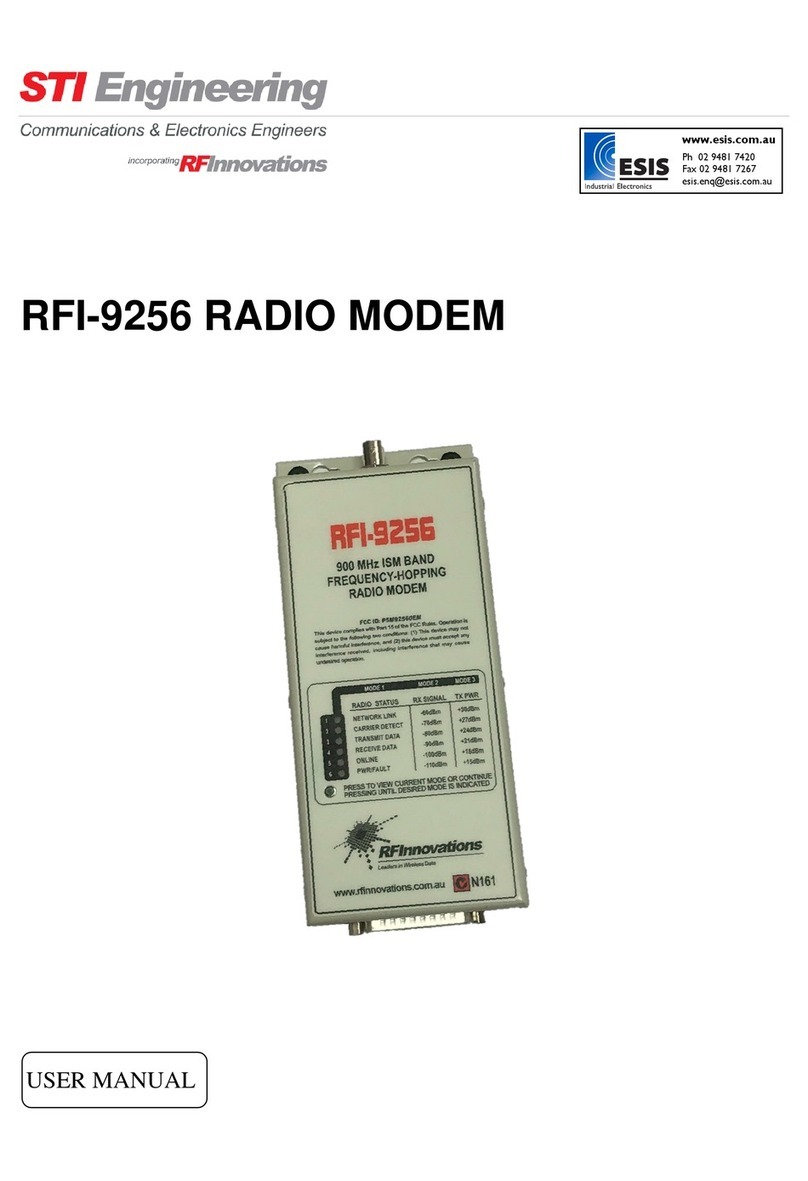Teledesign TS4000 User manual

TS4000
Radio Modem
User’s Manual
Version 5.32
1729 South Main Street
Milpitas, CA 95035
(408) 941-1808
(800) 663-3674
(408) 941-1818 Fax
www.teledesignsystems.com

This document is copyrighted by Teledesign Systems Inc. with all rights
reserved. No part of this document may be reproduced in any form without the
prior written consent of Teledesign Systems Inc.
Copyright
Copyright ©1995 - 2007 by Teledesign Systems Inc. All rights reserved.
This manual has been thoroughly reviewed for accuracy, and every effort has
been made to ensure that the information is accurate and complete. However,
different versions of this product have different features and capabilities, and this
manual reflects only one of those versions. Therefore, Teledesign Systems Inc.
assumes no responsibility for errors, omissions or defects in this material, and
shall not be liable for any damages resulting from their use.
Disclaimer
The information in this document is subject to change without notice.
TELEDESIGN SYSTEMS INC. MAKES NO WARRANTY OF ANY KIND WITH
RESPECT TO THIS DOCUMENT AND SOFTWARE, EITHER EXPRESSED OR
IMPLIED, INCLUDING WITHOUT LIMITATION ANY IMPLIED WARRANTIES
OF MERCHANTABILITY OR FITNESS FOR A PARTICULAR PURPOSE.

Emissions
FCC The TS4000 has been tested and found to comply with the limits for a Class B
digital device, pursuant to Part15 of the FCC rules (Code of Federal Regulations
47CFR Part 15). Operation is subject to the condition that this device does not
cause harmful interference.
Part 15
The TS4000 has been type accepted for operation by the FCC in accordance
with Part 90 of the FCC rules (47CFR Part 90). See the label on the unit for the
specific FCC ID and any other certification designations.
Part 90
The TS4000 has been type accepted for operation by the FCC in accordance
with Part 101 of the FCC rules (47CFR Part 101). See the label on the unit for
the specific FCC ID and any other certification designations.
Part 101
Industry Canada
This Class B digital apparatus meets all requirements of the Canadian
Interference-Causing Equipment Regulations.
ICES-003
The TS4000 has been certified for operation by Industry Canada in accordance
with RSS-119 and RSS-210 of the Industry Canada rules. See the label on the
unit for the specific Industry Canada certification number and any other
certification designations.
RSS-119
Changes or modifications not expressly approved by Teledesign Systems Inc.
could void the user’s authority to operate this equipment.
Notice
Shielded cable must be used with this equipment in order to ensure that it meets
the emissions limits for which it was designed. It is the responsibility of the user
to obtain and use good quality shielded cables with this device. Shielded cables
are available from most retail and commercial suppliers of cables designed to
work with radio equipment and personal computer peripherals.
The frequency band from 406.0 to 406.1 MHz is reserved for use by distress
beacons. As such, the TS4000 should not be programmed to transmit on any
frequency within this band. Caution should be used when programming
frequencies into the TS4000 to eliminate the possibility of TS4000 users
interfering with rescue operations on this band.
406.0 to 406.1 MHz
Operation
In order to ensure the safe operation of this radio equipment, the following
practices should be observed.
Safety Warning
•DO NOT operate radio equipment near electrical blasting caps or in an
explosive atmosphere.
•DO NOT operate any radio transmitter unless all RF connectors are secure
and any open connectors are properly terminated.
•DO NOT allow the antenna to come close to, or touch, the eyes, face, or any
exposed body parts while the radio is transmitting.
TS4000 Radio Modem User’s Manual Emissions iii

Table of Contents
Emissions......................................................................................................iii
FCC.................................................................................................... iii
Industry Canada................................................................................. iii
Notice.......................................................................................................iii
406.0 to 406.1 MHz Operation ...............................................................iii
Safety Warning .......................................................................................iii
Table of Contents..........................................................................................iv
TS4000 Overview ...........................................................................................1
Introduction..............................................................................................1
Features....................................................................................................1
Model Numbers........................................................................................3
Radio Modules.........................................................................................3
Frequency Bands................................................................................3
Transmit Power...................................................................................3
Channel Spacing and Bandwidth........................................................4
Enclosure.................................................................................................4
Standard .............................................................................................4
Watertight............................................................................................4
Connections.............................................................................................5
Serial Port...........................................................................................5
Antenna Connector.............................................................................5
Power Connection...............................................................................5
Mounting ..................................................................................................6
Configuring the TS4000..........................................................................6
AirTest - Data Testing.............................................................................6
Upgrading the TS4000 Firmware...........................................................6
AirScan.....................................................................................................6
Remote Diagnostics................................................................................6
AirCalc - Range Estimation....................................................................7
Status Lights............................................................................................8
Configuration Program..................................................................................9
Using Help................................................................................................9
System Requirements.............................................................................9
Installation................................................................................................9
TS4000 to PC Connection.......................................................................9
Programming and Retrieving Configurations....................................10
Storing Configurations.........................................................................10
Diagnostics............................................................................................11
Diagnostics Screen...........................................................................11
Modem Hardware Screen.................................................................12
Radio Hardware Screen ...................................................................12
Serial Port.....................................................................................................13
RS-232 Serial Port Basics.....................................................................13
Connectors........................................................................................13
DCE vs. DTE.....................................................................................13
Asynchronous Data ..........................................................................13
Flow Control......................................................................................13
Serial Port Connector ...........................................................................14
Signal Levels..........................................................................................14
TS4000 Radio Modem User’s Manual Table of Contents iv

Signal Options.......................................................................................14
RI Pin Signal Options........................................................................15
DSR Pin Signal Options....................................................................15
DTR Pin Signal Options....................................................................15
Configuration Options..........................................................................16
Serial Port 2............................................................................................19
Radio Setup..................................................................................................21
Configuration Options..........................................................................21
Clear Channel Scan..........................................................................23
Redundancy......................................................................................23
Frequency Programming......................................................................26
406.0 to 406.1 MHz Operation..........................................................26
Methods of Programming Channels.................................................26
Frequency Configuration Screen......................................................27
Channel Switching................................................................................28
Channel Change with a Control String .............................................28
Compatibility..........................................................................................29
AirNet Packet Protocol................................................................................31
Overview.................................................................................................31
Configuration Options..........................................................................33
Packet General.................................................................................33
Packet for Port..................................................................................35
Control and Status Strings...................................................................38
Control Strings..................................................................................38
Status Strings....................................................................................39
Master-Slave System Setup .................................................................40
Setting Packet Timeout.....................................................................40
Data Packet Transmit Time ..............................................................41
Polled System with Store and Forward Repeaters............................42
Single Repeater System...................................................................43
Dual Repeater System......................................................................45
Three Repeater System....................................................................47
Chain Repeater System....................................................................49
Other System Topologies .................................................................51
CSMA System Setup.............................................................................52
Basic System - Setup Summary.......................................................52
System with Repeaters - Setup Summary........................................53
Setting Slot Time...............................................................................55
Setting Min Idle Slots........................................................................55
Setting Tx Index................................................................................56
Setting Packet Timeout.....................................................................58
Data Packet Delay............................................................................59
GPS Configuration.......................................................................................61
Configuration Options..........................................................................61
Testing ..........................................................................................................64
AirTest....................................................................................................64
Data Test ..........................................................................................64
BER Test...........................................................................................65
AirScan...................................................................................................66
AirScan Controls...............................................................................66
Remote Diagnostics ....................................................................................67
Remote Diagnostics with Repeaters ................................................67
TS4000 Radio Modem User’s Manual Table of Contents v

Remote Diagnostics Screen.............................................................67
Remote Diagnostic Controls.............................................................67
Remote Diagnostics Request and Response Strings ......................69
Upgrading Firmware....................................................................................70
Upgrading...............................................................................................70
Licensing ......................................................................................................71
User’s License.......................................................................................71
Channel Spacing and Occupied Bandwidth.....................................71
USA (FCC)........................................................................................72
International......................................................................................72
Unlicensed Operation ...........................................................................72
Frequencies and Channel Bandwidth...............................................72
Power................................................................................................73
Manufacturer’s Certification ................................................................73
USA (FCC)........................................................................................73
Industry Canada................................................................................74
International......................................................................................74
Service and Support....................................................................................75
Contacting Teledesign..........................................................................75
Returning Equipment............................................................................75
Warranty........................................................................................................76
Appendix A - Serial Ports............................................................................77
Standard Case .......................................................................................77
Serial Port 1 Pinout...........................................................................77
Serial Port 2 Pinout...........................................................................77
Watertight Case.....................................................................................77
Pinout................................................................................................77
Standard RS-232 Serial Port Pinout ....................................................79
Standard Usage of the RS-232 Control Signals.................................79
Signal Levels..........................................................................................80
Appendix B – ASCII Character Set.............................................................81
Appendix C - Specifications .......................................................................82
General...................................................................................................82
Specifications: TS4000-02A .................................................................83
Specifications: TS4000-05B .................................................................84
Specifications: TS4000-05C .................................................................85
Specifications: TS4000-05D .................................................................86
Appendix D - Case Dimensions..................................................................87
Appendix E – Control and Status Strings .................................................89
General Strings.................................................................................89
Frequency Control Strings................................................................89
Modem Configuration Strings...........................................................89
Packet Strings...................................................................................90
Diagnostics Strings...........................................................................91
Appendix F – Internal Jumper Block .........................................................95
Factory Default Jumper Settings ......................................................95
Instructions for Accessing the Jumpers............................................95
TS4000 Radio Modem User’s Manual Table of Contents vi

Jumper Settings for Power on Serial Port 1 - Pin 9..........................96
Jumper Settings for Power on Serial Port 1 - Pin 4..........................96
Jumper Settings for Power on Serial Port 2 - Pin 9..........................97
Jumper Settings for TTL Levels on Serial Port 1..............................97
Appendix G – FCC MURS Rules.................................................................98
TS4000 Radio Modem User’s Manual Table of Contents vii

TS4000 Radio Modem User’s Manual TS4000 Overview 1
TS4000 Overview
The TS4000 Radio Modem is an integrated radio and modem designed for the
wireless transmission of digital data. The TS4000 can transfer data at rates up
to 19,200 bits per second. The TS4000 includes a synthesized VHF, UHF or 900
MHz transceiver that can be programmed for up to 99 channels.
Introduction
This product is ideally suited to OEMs and system integrators who require a
versatile radio modem in a single package. The TS4000 is configured with
windows based PC configuration software.
Main Features
Features High speed channel rates up to 19,200 bits per second.
Selectable operating modes for transparent and packet data operation.
High efficiency switching voltage regulator provides a wide input voltage
range and uses minimum power regardless of the input voltage.
Provides addressed communications for devices that are not directly
addressable themselves.
Includes store-and-forward data repeating for wide area coverage.
Provides two individually configurable data ports.
Supports data activation (three wire) and RTS/CTS handshake protocols.
Configurable RF output power levels.
Programmable receive sensitivity level (squelch) for use on noisy channels.
Watertight case option for outdoor use and marine installations.
Clear Channel Scan - The TS4000 will automatically and dynamically select
the best channel for communication without intervention from the host
equipment.
Automatic CW Station ID - The TS4000 can be configured to periodically
transmit a Morse code station ID.
Remote Diagnostics allows the status of remote TS4000s to be checked
over the air.
Flexible Data Interface
Two highly configurable user data serial ports.
Primary port supports connection to virtually any asynchronous user device.
Second port can be used for configuration, control and remote diagnostics.
Full handshake and data activation modes supported on serial port 1.
Data activation mode requires only receive and transmit data lines for full
communication with user device.
Data rates from 300 to 38,400 baud.
RS-232, RS-485 or TTL signal levels.
Integrated RF Transceiver
Synthesized transceivers cover VHF, UHF and 900 MHz bands.
Programmable RF output power levels.
Channel frequencies are stored in internal flash memory and are selectable
on-the-fly using simple ASCII command strings.
Selectable Channel Protocols
User selectable scrambling codes for private network communications.
Optional Forward Error Correction (FEC) using block coding and interleaving
corrects channel induced errors.
User selectable transparent or AirNet packet data transfer modes.

TS4000 Radio Modem User’s Manual TS4000 Overview 2
Integrated AirNet Packet Data Protocol
Allows user directed transmissions to only selected destinations.
Provides addressed communications for devices that are not directly
addressable themselves.
Can be optimized for point to point, point to multi-point and full mesh
networks.
Supports group and all-call broadcast transmissions.
Built in CSMA/CA algorithm minimizes transmission collisions to maximize
channel efficiency and utilization.
Individual TS4000s can be configured as store-and-forward data repeaters to
extend radio network coverage.
Remote Diagnostics
Allows the status of remote TS4000s to be checked, over the air, from any
other TS4000.
Parameters include: RSSI (inbound, outbound and repeater), Input Voltage,
Radio Voltage, Temperature, Path (direct of through one or more store and
forward repeaters), and Transmit Power (not available on all units).
Allows for the test and verification of a system independent of host
equipment (RTU, GPS, etc,).
Provides easy determination of the radio coverage and signal quality
between TS4000s.
Available while the system is in normal operation.
Can be used through Serial Port 1 or Serial Port 2 of the TS4000.
Windows display software provided, free of charge, with the TS4000
Configuration Software.
Remote Diagnostics function is available to other equipment through the use
of control strings.
Upgrade available for all TS4000s. Contact Teledesign for pricing.
PC Configurable
Windows based configuration software provides quick setup and testing.
Flash memory program storage allows for easy in field firmware upgrades.
AirTest is included with the TS4000 configuration program. AirTest is a
general purpose wireless modem test program which can be used to verify
operation and to gather performance statistics (BER) about the link between
modems.
The TS4000 configuration program comes with AirScan that enables the
TS4000 to be used as a frequency scanner.
Rugged and Reliable
Optional watertight housing and connections designed to withstand abuse
from field and marine use.
External interfaces protected against voltage transients, reverse polarity,
electrical shorts and high VSWR.
Two year warranty.
Free technical support provided during all phases of installation and use.

TS4000 Radio Modem User’s Manual TS4000 Overview 3
The TS4000 comes in a number of models depending on the frequency of
operation, transmit power, and channel spacing. The model numbers for the
TS4000 are in the following format.
Model Numbers
TS4000-PPRFFCNO
Where:
PP - Maximum transmit power (in watts)
R- Radio module type
FF - Frequency band (see below)
C- Case type: S = Standard Case
W = Watertight Case
N- RF Connector:B = BNC (standard case)
T = TNC (watertight case)
S = SMA (option)
N = N (option)
O- Options B – Basic
R - Remote Diagnostics
Use the two digit value from this table for FF above.
TS4000 Frequency Band
Table
TS4000-02A
TS4000-05B TS4000-05C TS4000-05D
(2W, 5W UHF) (5W VHF) (5W 900MHz)
MHz : FF MHz : FF MHz : FF
380-403 : 38 132-150 : 13 928-960 : 93
403-419 : 41 150-174 : 15 --
419-435 : 42 -- --
435-451 : 44 -- --
450-470 : 45 -- --
464-480 : 47 -- --
480-496 : 48 -- --
496-512 : 49 -- --
The TS4000 consists internally of two modules - a modem module and a radio
module. The radio module has a number of options depending on the frequency
of operation, transmit power, and channel spacing. It is important that the
TS4000 is ordered with the correct radio module based on the operating
requirements.
Radio Modules
The radio module of the TS4000 comes in various frequency bands including
VHF, UHF and 900 MHz. Within each of these bands, there are sub-bands that
define the specific frequency range over which a particular radio module will
operate (i.e. 450 to 470 MHz).
Frequency Bands
For some of the frequency bands, there several options for the radio module
transmit power. The most common transmit power levels available are 2 watts
and 5 watts. The transmit power can be reduced from the maximum power with
the transmit power level setting control (See Radio Setup).
Transmit Power
The transmit power of the radio module effects the maximum transmit duty cycle
that the TS4000 can be operated with. Transmit duty cycle is the percentage of
time that the modem is transmitting (i.e. 50 %). If the TS4000 is operated with
too high a transmit duty cycle, then the radio module may get too hot which can
result in damage. The maximum safe transmit duty can be increased by
Transmit Duty Cycle

TS4000 Radio Modem User’s Manual TS4000 Overview 4
reducing the maximum environmental temperature, adding a heat sink to the
back plate of the TS4000, or reducing the transmit output power output.
If more transmit power is desired than the internal TS4000 radio module can
provide then an external power amplifier can be used to boost the power. For
connection to the TS4000 it is important that the power amplifier have automatic
power sensing to switch between receive and transmit modes. It is also
important that the power amplifier has fast power switching so that the TS4000
transmit attack time (amount of time to initiate a transmission) does not have to
increased excessively.
Power Amplifiers
For some frequency bands, there are multiple options for the radio module
channel spacing and bandwidth.
Channel Spacing and
Bandwidth
The channel spacing defines how close together the channels are within a band
(i.e. 12.5 kHz). To use channels with a particular channel spacing, the radio
module’s frequency synthesizer must be programmable to multiples or sub-
multiples of the channel spacing. The TS4000 radio module should be ordered
based on the channel spacing of the channels to be used.
Channel Spacing
The channel bandwidth is the amount of frequency spectrum that the radio
transmit signal is allowed to occupy (i.e. 16 kHz). This bandwidth must be
controlled in order to minimize the interference between users on adjacent
channels.
Channel Bandwidth
For the TS4000, the data rate and the type of modulation control the transmitted
channel bandwidth. Therefore, it is important that the TS4000 is setup so that its
transmitted bandwidth is less than that prescribed for the channels being used
(See Radio Setup, Licensing).
Transmit Channel
Bandwidth
The receive filters of the TS4000 radio module are designed for a specific
channel bandwidth. The radio module should be ordered with a receive filter
bandwidth that matches the bandwidth of the channels used.
Receive Channel
Bandwidth
Note that if multiple channel bandwidths are to be used, then the radio module
should be ordered for the channel with the highest channel bandwidth. This may
result in less than optimal performance on channels with narrower channel
bandwidths.
The TS4000 is available in either a standard or watertight enclosure (see
Appendix D - Case Dimensions).
Enclosure
The standard enclosure has four external connectors - an antenna connector, a
power connector and two serial port connectors.
Standard
The watertight enclosure is environmentally sealed and is designed to withstand
dust, rain and water splashes.
Watertight
Caution: The watertight enclosure should not be submerged in water.
The watertight enclosure has two external connectors - an antenna connector
and an interface connector that provides the serial port and power connections.
The interface connector is a 19 pin LEMO connector. The mating connector for
this is a LEMO FGG.2B.319 series connector.

TS4000 Radio Modem User’s Manual TS4000 Overview 5
Connections
The TS4000 has two serial ports that provide a data connection between the
TS4000 and the host equipment. The serial ports are standard RS-232
asynchronous serial interfaces and are setup as DCEs. The serial ports provide
all the standard RS-232 handshake lines. In addition, the TS4000 provides a
number of configuration options that allow the serial port line usage to be
customized for different host equipment (see Serial Port Configuration Options).
Serial Port
Serial port 1 can be configured for either RS-232 or TTL signal levels. To
change the signal level setting, the modem must be opened and the four jumper
plugs next to the serial port connector moved to the desired position (See
Appendix A - Serial Port, Appendix F - Internal Jumper Block).
Signal Levels
The serial port connectors are standard 9 pin subminiature D with female pins.
These ports can be mated to with standard PC serial cables. To minimize
emissions and interference, the serial cables used should be good quality
shielded cable (See Appendix A - Serial Port).
Standard Case
The watertight case provides the serial port connections through a single sealed
interface connector (See Appendix A - Serial Port).
Watertight Case
A variety of antennas can be used with the TS4000, but it is important that the
antenna provides a 50 ohm load at the radio’s operational frequencies. In
addition, all cabling used with the antenna must be good quality coaxial cable
with 50 ohm impedance.
Antenna Connector
Caution: The modem should never be allowed to transmit without an
antenna or dummy load attached to the antenna connector.
The standard case comes with a 50 ohm female BNC antenna connector.
Standard Case
The watertight case comes with a 50 ohm female TNC antenna connector.
Watertight Case
The TS4000 requires a DC supply voltage between 9 and 28 volts. Note that the
minimum supply voltage depends on the particular radio module in the TS4000.
In addition, the power (watts) used by the TS4000 also depends on the particular
radio module.
Power Connection
Internally, the TS4000 has a high efficiency switching voltage regulator (as
opposed to a linear voltage regulator). The switching regulator minimizes the
amount of power that the TS4000 requires. Also, the power required (watts) is
independent of the input supply voltage.
Switching Regulator
The power supply current required depends on the input voltage used. This can
be calculated with the following formula.
Power Supply Current
Max Power Supply Current (amps) = Max Power (watts) / Input Voltage
Max Power = 10 watts (The actual value depends on the particular radio module
in the TS4000).
Example
Power Supply Voltage = 20 volts
Max Power Supply Current = 10 / 20 = 0.5 amps

TS4000 Radio Modem User’s Manual TS4000 Overview 6
With the standard case power can be connected through either the power
connector or one of the serial port connectors. The power connector is a 2 pin
Molex Micro-Fit 3.0 (Molex P/N 43045-0202) with pin 1 as ground and pin 2 as
power. The mating plug for this connector is a Molex P/N 43025-0200. See the
Serial Port section for details on connecting power through the serial ports.
Standard Case
With the watertight case power is connected through the sealed interface
connector.
Watertight Case
The TS4000 has an internal 4 amp fuse for each of the three possible power
connections. The power source used with the TS4000 should also be fused with
an in-line power fuse.
Fuses
The preferred method of mounting the TS4000 is to use the mounting bracket
supplied with the modem. An alternative is to use the threaded mounting holes
in the bottom of the TS4000 (see Appendix D - Case Dimensions).
Mounting
The TS4000 is supplied with a windows based PC configuration program.
Configuring the TS4000 consists of configuring the modem operating parameters
and also configuring the frequency channels. For details on how to load and
start the configuration program see Installation in the TS4000 Configuration
Program section.
Configuring the
TS4000
Making selections with the controls on the various configuration screens sets a
configuration. Once set, configurations can be programmed into the TS4000. In
addition, configurations can be retrieved from the TS4000. Configurations can
also be stored and recalled as PC files. Details about the configuration controls
are available later in this manual and in the on line help of the configuration
program.
Teledesign provides general-purpose wireless modem test software
called AirTest. AirTest can send data and gather performance statistics,
including BER (Bit Error Rate), about the link between two modems.
AirTest is accessed with the AirTest button on the main screen of the
configuration program (See Testing - AirTest).
AirTest - Data
Testing
The TS4000 comes with flash program memory that allows the firmware to be
easily upgraded in the field. Firmware is upgraded with the upgrade program
which is included as part of the TS4000 configuration program. The upgrade
program is started with the Upgrade Firmware button on the main screen of the
configuration program (See Upgrading Firmware).
Upgrading the
TS4000 Firmware
AirScan is a program that comes with the TS4000 configuration program and
enables the TS4000 to be used as a frequency scanner. AirScan is useful for
determining the frequency and magnitude of potential interference within the
TS4000’s frequency band. AirScan is started with the AirScan button on the
main screen of the configuration program (See Testing - AirScan).
AirScan
Remote diagnostics is used to check the status of remote TS4000s over the air.
This allows the radio communication to be setup and tested independent of the
host equipment.
Remote
Diagnostics

TS4000 Radio Modem User’s Manual TS4000 Overview 7
Remote diagnostics is an extra cost firmware option which can be used with any
TS4000. The remote diagnostics firmware option upgrade is accomplished the
same way as a standard firmware upgrade (see Upgrading Firmware). Please
contact Teledesign for ordering information.
The remote diagnostics can be accessed using the Remote Diagnostics screen
in the TS4000 Configuration Program and can be operated through either serial
port. For more details see Remote Diagnostics.
Teledesign provides wireless range estimation software called AirCalc.
AirCalc provides estimates of the flat terrain range of wireless data
communication systems. Actual range of a system can vary
dramatically, and therefore it is important that range is verified with in field tests
in the area of operation. AirCalc is accessed with the AirCalc button on the main
screen of the configuration program.
AirCalc - Range
Estimation

TS4000 Radio Modem User’s Manual TS4000 Overview 8
The TS4000 has three lights (LED) indicators to provide operational status of
transmit (TX), receive (RX) and power (PWR) functions. Special combinations of
these indicators are used to indicate secondary operating modes and fault
conditions.
Status Lights
TS4000 State LEDs Indicator State
Normal Operation PWR
RX
TX
On when the TS4000 is powered.
On when the TS4000 detects activity on the
radio channel.
On when the TS4000 is transmitting.
Program Mode RX, TX Both on continuously.
Reset RX, TX Flash together four times.
Although the reset indication takes about
four seconds to complete, the TS4000 is
fully operational when the flashing
begins.
Transmit Test Mode TX Flashes for the duration of the test.
Invalid Frequency
Channel Fault RX, TX Alternately flash.
This fault occurs if the TS4000 is set for
a channel that does not have a valid
frequency programmed.
Transmit Buffer
Overflow TX Flashes between 6 and 16 times for each
occurrence depending on the details of the
overflow
Receive Buffer
Overflow RX Flashes between 6 and 16 times for each
occurrence depending on the details of the
overflow
Diagnostics Fault PWR Flashes for the duration of the fault.
In this mode the TS4000 has detected a
fault but continues to operate. Operation
may be unreliable due to the fault.
The most common cause of this state is an
out of range power source. The source of
the fault can be diagnosed with the
configuration program (see TS4000
Configuration Program, Diagnostics).
Catastrophic Fault RX, TX Alternately flash until the fault is cleared and
the TS4000 is reset.
In this mode the TS4000 has detected a
catastrophic fault and is non-operational
until the fault is corrected.
The source of the fault can be diagnosed
with the configuration program (see TS4000
Configuration Program, Diagnostics).

TS4000 Radio Modem User’s Manual Configuration Program 9
Configuration Program
The configuration program is used to configure the TS4000 for operation.
Configuring the TS4000 consists of independently configuring both the modem
operation and the radio frequency channels. The configuration program consists
of controls and menus. The controls set the configuration and test options. The
menus (line items at the top of the screen) execute program commands.
In addition to configuring the TS4000, the configuration program provides access
to AirTest (wireless modem test software), AirCalc (wireless range estimation),
AirScan (frequency scanning), TS4000 firmware upgrade program (see Testing,
Upgrading Firmware) and remote diagnostics (see Remote Diagnostics).
The configuration program has on-line help that contains information on how to
use the program and also detailed information on specific controls and menus.
Help is accessed by selecting a command from the help menu, pressing the
question button or pressing the F1 key.
Using Help
Personal computer using a 486 or faster
System
Requirements Microsoft Windows 95 or later
CD-ROM disk drive.
1) Put the CD-ROM in the PC.
Installation 2) Run the installation program.
3) Follow the installation instructions.
Serial Cable
TS4000 to PC
Connection To transfer configurations between the TS4000 and a PC, their serial ports must
be connected together. The serial cable used should be a standard straight
through (i.e. pin 1 to pin 1, pin 2 to pin 2, etc) serial cable. This is the same type
of cable used to connect a PC to a standard phone modem (See Serial Port).
Before configurations can be retrieved from and programmed into the TS4000
the configuration program must connect to the
TS4000. To connect, select the Connect to
Modem command from the Modem menu or
press the Connect to Modem button.
Connecting to the TS4000 puts it into
program mode which is indicated by the Rx
and Tx lights remaining on continuously.
Software Connection
When connected to the TS4000 the
configuration program may disable (lighter
shade) some of the controls. These disabled
controls are options that are not available with that particular TS4000's version of
firmware. These controls are re-enabled when the connection is broken (using
the Disconnect command from the Modem menu or the Disconnect button).

TS4000 Radio Modem User’s Manual Configuration Program 10
The configuration of the TS4000 can be read out of the modem by selecting the
Retrieve Configuration command from the Modem
menu or by pressing the Retrieve Configuration
button.
Programming and
Retrieving
Configurations
To program a configuration into the TS4000, use
the Program Configuration command from the
Modem menu or the Program Configuration
button.
CAUTION: Programming a configuration into
the TS4000 will write over (destroy) the
configuration currently in the TS4000. To avoid
losing the TS4000’s configuration information,
save the configuration by retrieving it and then
saving it as a PC file.
Configurations can be stored and recalled as PC files. This is done using the
commands under the File menu or the corresponding
buttons.
Storing
Configurations
Command Action
New/Default Create a new file with default values.
New/Default GPS Create a new GPS file with default values. The GPS file is a
stripped down version with just the controls needed for GPS
applications.
Open Open a previously stored file. The user is prompted with a
directory and file list.
Close Close the active file.
Save Save the active file under the current name.
Save As Save the active file under a different name or in a different
directory. The user is prompted with a directory and file list.
Convert to Converts the file between the GPS and standard format.
Recent File List This shows the last ten open files. A file can be recalled by
selecting its name from the list.

TS4000 Radio Modem User’s Manual Configuration Program 11
The configuration program can access diagnostics information from the TS4000.
This is done using commands under the Modem
menu or the corresponding buttons.
Diagnostics
Choose the Diagnostics menu to run, read and display diagnostic status of the
TS4000. The diagnostics tests the major components of the modem and also
monitors the power supply voltages.
Diagnostics Screen

TS4000 Radio Modem User’s Manual Configuration Program 12
Choose the Retrieve Modem Hardware menu to read and display the modem
hardware details. These include details on the firmware version and memory
configuration. These modem hardware values are set at the factory based on
the modem hardware included in the TS4000 and cannot be changed.
Modem Hardware
Screen
Choose the Retrieve Radio Hardware menu to read and display the radio
hardware details. This includes details about the radio’s frequency, channel
spacing and transmit power. These values are set at the factory based on the
radio hardware included in the TS4000 and cannot be changed.
Radio Hardware
Screen

TS4000 Radio Modem User’s Manual Serial Port 13
Serial Port
The serial port provides an asynchronous data connection between the TS4000
and the host equipment. The TS4000 serial port is a standard RS-232 serial port
with a number of options to allow connection to a wide variety of serial host
equipment.
The EIA (Electronic Industries Association) RS-232C standard is a standard for
short distance (less than 50 feet) serial communications. The standard defines
the electrical signal levels, interface characteristics and the operation of the
control signals (handshake lines). Although the standard defines the operation of
the handshake lines, there is significant variation in the way these signals are
used by different equipment.
RS-232 Serial Port
Basics
The RS-232 standard does not require the use of a specific connector. However,
most asynchronous RS-232 serial ports use either a 9 pin or 25 pin subminiature
D connector. The same signals are provided with both connectors, but of course
the pinouts are different (see Appendix A - Serial Port).
Connectors
RS-232 serial ports come in two varieties - DCE (Data Communication
Equipment) and DTE (Data Terminal Equipment). This defines the direction of
the serial port’s lines (driven or received). It also typically defines the polarity of
the connector. DCEs typically use female pin connectors and DTEs typically use
male pin connectors.
DCE vs. DTE
Connecting a DCE port to a DTE is the most common setup and requires a
standard straight through cable (i.e. pin 1 to pin 1, pin 2 to pin 2, etc.). When
connecting two DCEs or two DTEs together a null modem cable is required. The
purpose of a null modem cable is to cross connect the appropriate signals.
However, null modem cables are not all the same and therefore it is important to
verify that a specific cable is appropriate for a specific application.
The TS4000 is designed to work with asynchronous serial ports. Asynchronous
ports do not use clocks or timing signals to synchronize data transfers. Instead
data is framed into asynchronous characters which the ports synchronize to.
Asynchronous Data
An asynchronous character consists of a start bit, data bits and stop bits. The
start bit indicates the beginning of a character. The number of data bits varies,
but is typically between 7 and 9 bits. The data bits sometimes include a parity bit
that provides error check information with each character. The number of stop
bits also varies but is typically 1 or 2 bits.
Flow control is the method for controlling the flow of data between the DCE and
DTE. Flow control is used to prevent the DTE and DCE data receive buffers
from overflowing. There are several different methods used for flow control and
as with everything related to RS-232 there is no one standard. The two main
variations of flow control are hardware flow control that utilizes the RS-232
handshake lines and software flow control that utilizes characters sent along with
the normal data.
Flow Control
Hardware flow control typically uses two control lines, one for each direction of
data. When a port activates its flow control signal it is indicating its readiness to
receive data. Deactivating the flow control signal indicates that the port can no
longer receive data because its buffer is full or close to full.
Hardware Flow Control
Table of contents
Other Teledesign Radio Modem manuals
